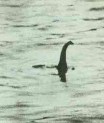The Loch Ness Monster and the Surgeon's Photo
 The Surgeon's Photo |
In 1933 the Daily Mail, taking advantage of the Nessie craze, hired a famous big-game hunter named Marmaduke Wetherell to travel up to the Loch to investigate the sightings and to find the monster, if he could. Although he found no monster, in December 1933 he did locate what appeared to be its tracks—enormous footprints on the shore of the Loch leading into the water. Unfortunately, when researchers from the Natural History Museum examined the tracks, they determined that they had been made with a dried hippo's foot, of the kind that were popularly used as umbrella stands. Humiliated, Wetherell retreated from public view.
A few months later, the Loch Ness monster was again in the news. A highly respectable British surgeon, Colonel Robert Wilson, was driving along the new road on the northern shore of the Loch on April 19, 1934 early in the morning when he said that he noticed something moving in the water. He happened to have a camera with him, so he quickly stopped his car and snapped a photo. The resulting image showed the slender neck of a serpent rising out of the Loch. For decades this photo was considered to be the best evidence ever obtained of the existence of a sea monster in the Loch. Wilson himself never publicized the image and refused to have his name associated with it. Therefore it came to be known simply as "The Surgeon's Photo."
For years skeptics were sure that the photo was somehow a hoax. But no rigorous studies of the image were conducted until 1984 when Stewart Campbell analyzed the photo in a 1984 article in the British Journal of Photography. Campbell concluded that the object in the water could only have been two or three feet long, at most, and that it probably was an otter or a marine bird. He suggested that it was likely that Wilson knew this to be the case. But as it turned out, Campbell was wrong. The object in the water was not a form of marine life. It was a toy submarine outfitted with a sea-serpent head. This was revealed in 1994 when Christian Spurling, before his death at the age of 90, confessed to his involvement in a plot involving both Wetherell and Colonel Wilson to create the famous 'Surgeon's Photo.'
According to Spurling, he had been approached by Wetherell (his stepfather) who wanted him to make a convincing serpent model. The model was then taken to Loch Ness, photographed, and the pictures were given to Wilson, whom Wetherell felt would be a creditable front man, since he was a surgeon. Apparently Wetherell's motive for concocting the elaborate plot was revenge, since he was still smarting from his humiliation over the hippo-foot tracks. "We'll give them their monster," his son later remembered him saying.
Updates:
- Loch Ness Monster Fossil a Hoax (National Geographic News, July 29, 2003)
- BBC Proves Nessie Does Not Exist (BBC News, July 27, 2003)
- Loch Ness Monster Fossil Found (Telegraph, July 16, 2003)
References/Further Reading:
| Main Page | Comments | Search Site |
Back to Gallery: 1914-1949 |
